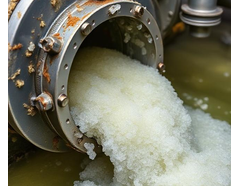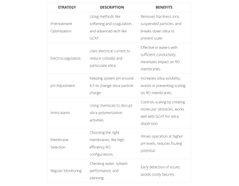
Prevent Silica Fouling in Industrial Systems: Strategies & Technologies
Silica fouling in industrial systems presents a major challenge, especially in reverse osmosis (RO) applications. Preventing this fouling condition requires understanding the behavior of silica in water. Operators need to understand and effectively implement sustainable strategies to mitigate this issue.
Silica is the seventh most abundant element in the universe and is common in nature. It’s found in most rocks as silicate minerals, with silicon dioxide (SiO2) being their basic building block.
This means silica is almost always present within industrial source water, process water, and wastewater streams. For industrial units, controlling silica levels in process water is essential to keep things running smoothly with lower maintenance to extend equipment life.

The Impact of Silica Fouling on Industrial Systems
Silica fouling can cause major issues for industrial equipment. It leads to less efficiency, increased maintenance, and potential system failures.
Here’s why it’s such a big concern:
- Scale Formation: Silica can build up on surfaces, forming water deposits called scale. This scale reduces heat transfer and limits water flow in piping systems.
- Membrane Fouling: In RO systems, silica particles can get stuck in membrane pores, blocking water flow. This mineral fouling reduces system performance and can cause permanent damage to the membrane surface.
- Energy Inefficiency: With scale buildup, equipment works harder to maintain the same performance, which elevates energy use.
- Shortened Equipment Lifespan: Constant silica fouling can prematurely wear out industrial equipment, leading to costly replacements. Proper raw water treatment is essential to extend the lifespan of industrial equipment.
To show how serious this is, many places worldwide, including the western USA, Hawaii, Puerto Rico, Mexico, and Southeast Asia, have water with silica levels from 30 to 120 mg/L. In Mexico City, for example, process water often has around 50-80 mg/L of silica. Effective and innovative water treatment solutions are necessary to mitigate damage from silica fouling issues.
Strategies to Prevent Silica Fouling in Industrial Systems
Now that we know the problems caused by silica fouling, let’s look at some ways to prevent it. Water clarification processes are important to mitigate the risks of silica fouling.
1. Pretreatment Optimization
One of the most important steps in preventing silica fouling is optimizing pretreatment processes. This includes conventional lime softening.
Lime softening removes hardness ions that can react with silica to create scale. Coagulation helps get rid of suspended particles, including some types of silica. However, lime softening is costly due to its large sludge generation.
GCAT (Genesis Catalytic Activation Technology) is a new innovative treatment method that uses specialized catalytic bead media. These unique beads break up silica particles by changing their shape and charge, which helps prevent colloidal and reactive silica fouling on RO membranes before silica scale can form without requiring energy to operate.
2. Electrocoagulation
Specialized batch or continuous electrocoagulation is very effective at reducing colloidal and particulate silica. These systems are typically used with post clarification systems. This approach reduces silica scale in the raw water optimizing RO membrane maintenance.
This method is especially helpful in waters with enough conductivity greater than 1000 mg/l TDS. It can be part of a comprehensive raw water pretreatment strategy with varying levels of silica present.
3. pH Adjustment
Silica’s solubility depends on pH. Adjusting the system’s pH, usually to about 8.5, can change the charge of silica particles.
This change can assist with common RO membrane scaling. This pH adjustment is crucial in both process water treatment and cooling tower water treatment to reduce the risks of silica fouling in association with appropriate treatment.
4. Use of Antiscalants
Specific antiscalants can assist in reducing silica polymerization, dispersing these molecules from the membrane surface. Several studies have shown that low doses of specific antiscalants, along with GCAT (Genesis Catalytic Activation Technology) systems, can manage silica scale, especially in water sources with lower TDS, and colloidal/reactive silica concentrations less than 100 mg/l. This can significantly improve permeate water recovery rates.
5. Membrane Selection and Configuration
Picking the right membrane and system setup greatly affects silica fouling prevention. High-efficiency reverse osmosis system configurations can work at higher pH levels.
This optimized design increases silica solubility and lowers fouling potential. These systems are part of advanced boiler feed water treatment solutions.
6. Regular Monitoring and Maintenance
Having a strong monitoring program is essential to prevent silica fouling. This includes regular water analysis to check silica levels and other important factors.
It also involves watching system performance indicators like pressure drop and flow rates. Using predictive maintenance helps solve potential problems before they get worse.
This maintenance extends to equipment like filter press cloths plates to ensure continuous treatment efficiency.
Advanced Technologies for Silica Fouling Prevention
As industrial water treatment advances, new innovative technologies are appearing to deal with silica fouling. Here are some advanced methods.
1. Zeoturb Liquid Bio-Organic Flocculant Technology
Zeoturb is a new sustainable liquid clarification technology is effective for turbidity removal, total suspended solids, trace metals and certain additional organic and inorganic contaminants. This method can also be very effective at reducing colloidal silica from water streams.
It enhances the overall water clarification process and can be integrated with other technologies like electrocoagulation or catalytic activation technology for enhanced performance.
2. High Crossflow Systems
High crossflow systems create turbulent flow, which helps stop silica particles from settling and forming scale on membrane surfaces. These systems improve the efficiency of ion exchange polishing as required.
3. Membrane Surface Modification
Research on membrane surface properties and their link to silica scaling is creating new ways to prevent fouling conditions. Scientists aim to make more fouling-resistant systems by adjusting membrane surface chemistries to repel silica particles.
4. Ion Exchange
Ion exchange is a notable process. Ion exchange is effective for removing reactive silica.
Specialized resins capture dissolved silica, preventing it from forming scale. This process can be used with other methods for comprehensive silica control. For tougher applications, upcore ion exchange can provide enhanced performance. However, this technology is typically used in limited applications due to the continuous need for regeneration chemicals.
5. Advanced Filtration Methods
Besides traditional methods, advanced filtration techniques are used. Natzeo filtration is an example.
These methods remove larger particles and reduce the load on downstream processes. Specific carbon filtration media is used to reduce organic compounds that contribute to fouling. Using things like cartridge filtration help polish the water, removing fine particles.
6. Integration of Multiple Technologies
Combining different technologies often provides the best defense against silica fouling. A system might use electrocoagulation, Zeoturb and also specialized media filtration for polishing.
It is important to remember the integration of treatment technologies may provide more effective performance than a singular treatment technology alone.
Using the GCAT catalytic activation technology along side specific antiscalant dosing is another effective integration of technology prior to an RO application. These integrated approaches address various forms of silica and contaminants. These are common components in process engineering designs.
Case Study: Silica Fouling Prevention in a Power Plant
To show how well these strategies work, let’s look at an example:
A power plant in the western US struggled with silica fouling in its cooling water. The plant’s water source had silica levels of 85 mg/L, causing frequent scaling and lower efficiency.
The plant used a complete silica fouling prevention strategy:
- They set up a GCAT pretreatment system to break down silica particles.
- pH adjustment was used to keep levels around 8.3.
- A special antiscalant program was started.
- Regular monitoring and maintenance were established.
Results:
- Silica levels in the cooling tower water were kept under control, even with higher concentration cycles.
- Scaling incidents dropped by 75% over 12 months.
- The plant increased water efficiency by 15% due to higher concentration cycles.
- Annual maintenance costs for silica fouling decreased by 60%.
This case shows that with the right mix of technologies and strategies, silica fouling can be managed, even in tough water conditions. This approach can be adapted for other industrial process water requirements, beverage bottling and municipal drinking water systems too.
Strategies to Prevent Silica Fouling

Conclusion
Preventing silica fouling is not just a maintenance issue—it is an essential component of efficient and sustainable industrial water treatment operations.
By leveraging integrated solutions such as (GCAT) catalytic activation technology, electrocoagulation, and precise pH adjustments along with high efficiency membrane system design, you can optimize RO maintenance, extend equipment life, reduce downtime and operating costs.
With growing water scarcity, and the rising demand for water conservation and reuse preventing silica fouling is one of the keys to enable sustainable industrial operations.
Don’t let silica fouling compromise your system’s performance.
FAQs about Prevent Silica Fouling in Industrial Systems
How do you prevent silica scaling?
To prevent silica scaling, combine pretreatment methods like electrocoagulation and clarification using Zeoturb.
Additionally, implement pH adjustment, antiscalants, and technologies like GCAT especially in RO membrane pretreatment applications.
Regular monitoring and maintenance are essential. This is a comprehensive strategy within water treatment.
How do you reduce silica in water?
Silica can be lowered in water through different methods. This includes ion exchange for reactive silica and membrane filtration for colloidal and reactive silica.
Special treatments like electrocoagulation or GCAT technology also help. Using specialty continuous electro deionization systems enhance silica removal post RO technology for applications requiring ultra pure water like semiconductor fabrication.
Does RO remove silica?
Yes, reverse osmosis (RO) can remove both reactive and colloidal silica. However, high silica levels typically cause membrane fouling.
So, good pretreatment and high efficiency system design are essential for long-term silica removal.
How do I reduce silica in my boiler?
To lower silica in boilers, use a thorough water treatment plan. Include pretreatment to remove silica from feed water and use suitable chemical treatments only as necessary.
Also ensure regular blowdown cycles to avoid silica buildup. Monitoring and keeping proper pH levels are crucial for boiler feed water treatment as well.
Customer comments
No comments were found for Prevent Silica Fouling in Industrial Systems: Strategies & Technologies. Be the first to comment!
